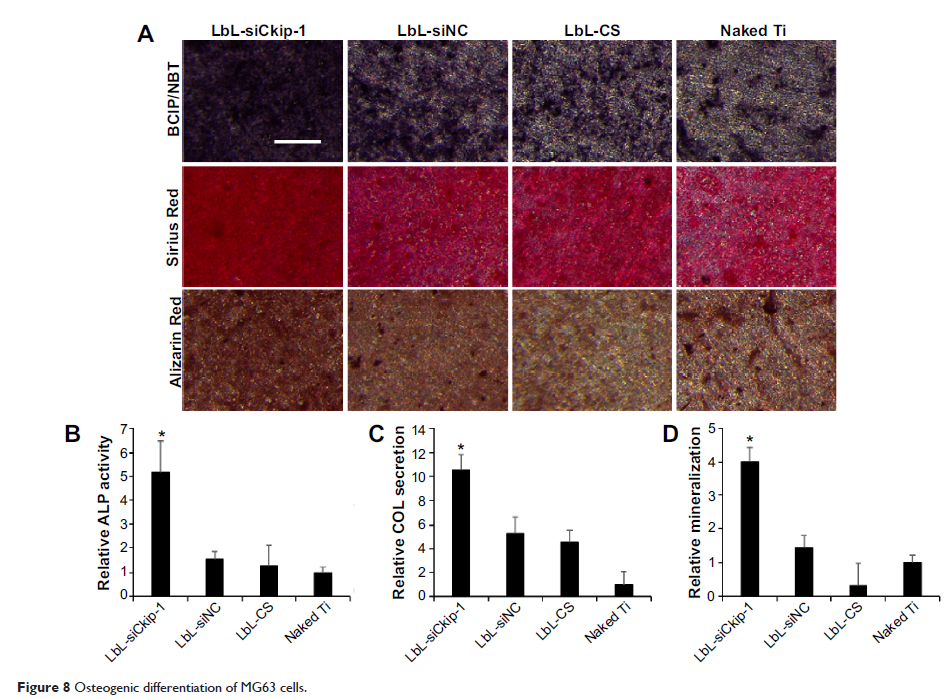109669
论文已发表
注册即可获取德孚的最新动态
IF 收录期刊
- 3.4 Breast Cancer (Dove Med Press)
- 3.2 Clin Epidemiol
- 2.6 Cancer Manag Res
- 2.9 Infect Drug Resist
- 3.7 Clin Interv Aging
- 5.1 Drug Des Dev Ther
- 3.1 Int J Chronic Obstr
- 6.6 Int J Nanomed
- 2.6 Int J Women's Health
- 2.9 Neuropsych Dis Treat
- 2.8 OncoTargets Ther
- 2.0 Patient Prefer Adher
- 2.2 Ther Clin Risk Manag
- 2.5 J Pain Res
- 3.0 Diabet Metab Synd Ob
- 3.2 Psychol Res Behav Ma
- 3.4 Nat Sci Sleep
- 1.8 Pharmgenomics Pers Med
- 2.0 Risk Manag Healthc Policy
- 4.1 J Inflamm Res
- 2.0 Int J Gen Med
- 3.4 J Hepatocell Carcinoma
- 3.0 J Asthma Allergy
- 2.2 Clin Cosmet Investig Dermatol
- 2.4 J Multidiscip Healthc

壳聚糖/ siRNA 的官能钛表面通过逐层的方法被用于体外持续的基因静默和成骨促进
Authors Song W, Song X, Yang C, Gao S, Klausen LH, Zhang Y, Dong M, Kjems J
Published Date March 2015 Volume 2015:10 Pages 2335—2346
DOI http://dx.doi.org/10.2147/IJN.S76513
Received 28 October 2014, Accepted 7 December 2014, Published 24 March 2015
Abstract: Titanium
surface modification is crucial to improving its bioactivity, mainly its bone
binding ability in bone implant materials. In order to functionalize titanium
with small interfering RNA (siRNA) for sustained gene silencing in nearby
cells, the layer-by-layer (LbL) approach was applied using sodium hyaluronate
and chitosan/siRNA (CS/siRNA) nanoparticles as polyanion and polycation,
respectively, to build up the multilayered film on smooth titanium surfaces. The
CS/siRNA nanoparticle characterization was analyzed first. Dynamic contact
angle, atomic force microscopy, and scanning electron microscopy were used to
monitor the layer accumulation. siRNA loaded in the film was quantitated and
the release profile of film in phosphate-buffered saline was studied. In vitro
knockdown effect and cytotoxicity evaluation of the film were investigated
using H1299 human lung carcinoma cells expressing green fluorescent protein
(GFP). The transfection of human osteoblast-like cell MG63 and H1299 were
performed and the osteogenic differentiation of MG63 on LbL film was analyzed.
The CS/siRNA nanoparticles exhibited nice size distribution. During formation
of the film, the surface wettability, topography, and roughness were alternately
changed, indicating successful adsorption of the individual layers. The
scanning electron microscope images clearly demonstrated the hybrid structure
between CS/siRNA nanoparticles and sodium hyaluronate polymer. The cumulated
load of siRNA increased linearly with the bilayer number and, more importantly,
a gradual release of the film allowed the siRNA to be maintained on the
titanium surface over approximately 1 week. In vitro transfection revealed that
the LbL film-associated siRNA could consistently suppress GFP expression in
H1299 without showing significant cytotoxicity. The LbL film loading with
osteogenic siRNA could dramatically increase the osteogenic differentiation in
MG63. In conclusion, LbL technology can potentially modify titanium surfaces
with specific gene-regulatory siRNAs to enhance biofunction.
Keywords: sustained gene
silencing, osteogenic differentiation, chitosan, small interfering RNA,
titanium
